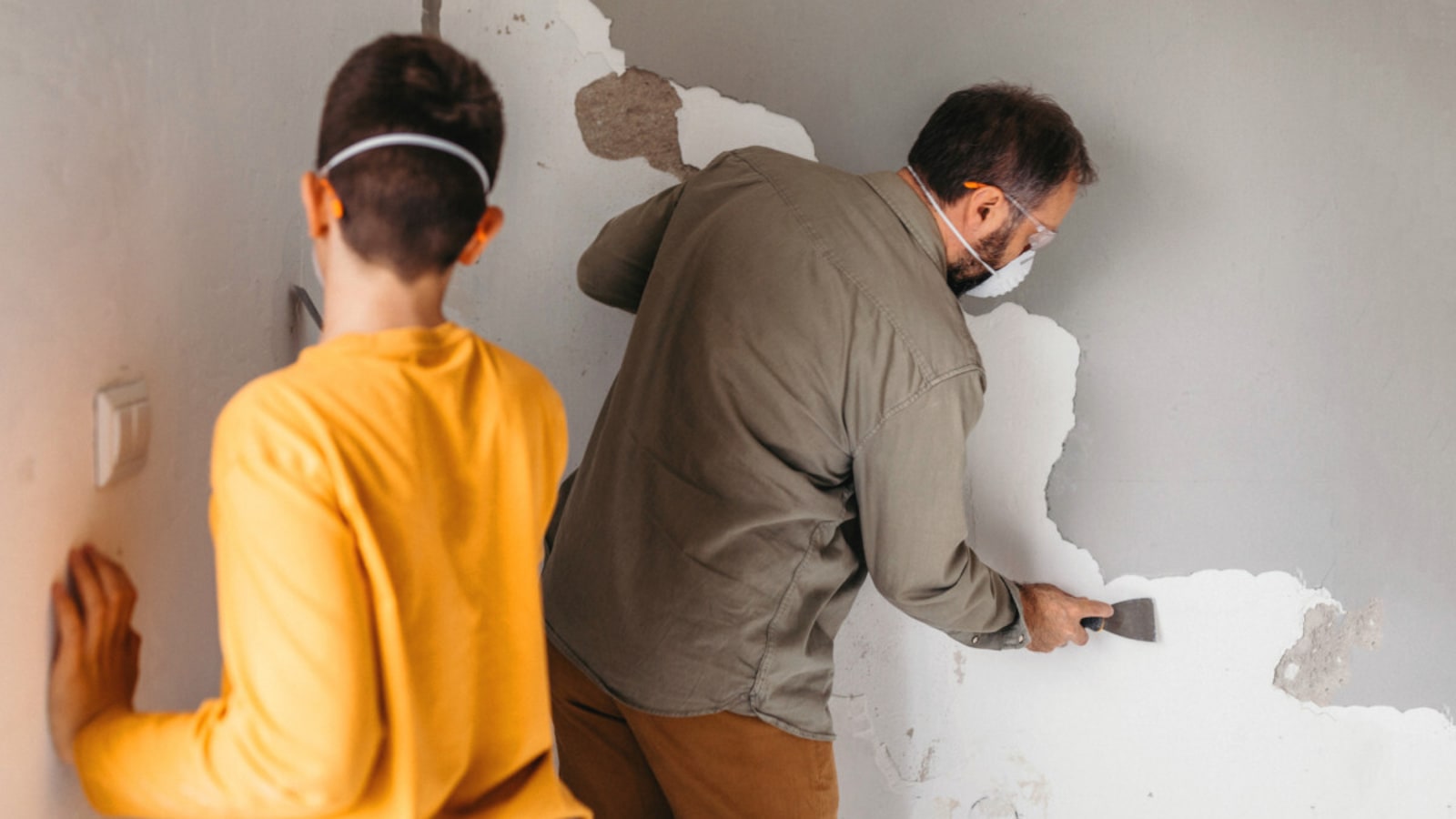
Drywall is a staple in most homes, offering smooth, clean walls that can last for years. But accidents happen—holes, cracks, and water damage are inevitable over time. While minor damage is easy to patch, larger problems might call for a full replacement piece. Knowing what type of damage calls for drywall replacement vs. drywall patch can help you avoid recurring issues and keep your wall surfaces looking their best.
When Patching Works and When It Doesn’t
Patching drywall holes can be quick and effective, but we don't think it's always the right fix.
Dealing with a little bit of damage? There’s no need to rip a wall from the studs for small cracks, dented drywall paper, nail holes, or minor repairs that are no larger than a couple of inches wide. Minor imperfections can be filled with patch kits, coat of spackle or joint compound, then sanded with fine-grit sandpaper and painted for a smooth finish.
But if the issue goes beyond surface-level drywall damage, patching might not hold up. Here’s when replacing drywall is usually the better choice:
- Holes larger than 6 inches: Large drywall holes often require more than just patching; they could compromise the structural integrity.
- Extensive cracks: Multiple or long drywall cracks might signal underlying problems like shifting walls, a drywall repair may just be a future crack waiting to happen.
- Water damage: Stains, bubbling, or soft spots are signs it’s been compromised by water leaks and should be replaced to prevent mold growth.
- Mold or mildew: Even small amounts of mold mean the wall is no longer safe to keep. Mold spreads quickly and can pose health risks.
- Sagging or warping: This is usually a sign of water damage or structural issues, both of which call for replacement.
How to Replace a Section of Drywall
Drywall Tools and Materials
Before you start, gather these tools and supplies:
- A drywall patch or a new piece of drywall
- Drywall saw
- Joint compound (also called drywall mud)
- Joint tape (aka drywall tape, paper tape, fiberglass mesh tape)
- Drywall screws or repair clips (depending on type of repair)
- Drill or screwdriver
- Sandpaper or sanding sponge (fine grit)
- Utility knife
- Putty knife (aka joint knife, drywall knife)
- 6-inch drywall knife or 12-inch drywall taping knife (for larger repairs)
- Wall paint and primer
- Paint Brush
Replacing Part of a Drywall Panel
Replacing part of a drywall panel can sound intimidating, but it’s manageable with the right approach. This process works well for moderate damage that doesn’t require replacing an entire drywall panel.
- Mark the damaged area: Use a ruler or straightedge to outline the piece you need to remove. Cut a square shape or rectangle for easier replacement. (Sometimes we reverse this process and cut the square piece of patch first THEN mark the square hole.)
- Cut out the damaged section: Use a utility knife or plunge saw to carefully cut along your lines. Be cautious of electrical wires or pipes behind the wall.
- Attach support strips: If there are no wall studs present, place wooden furring strips inside the wall behind the outer edges of the square hole and secure the piece of wood with drywall screws. This will support the new drywall patch.
- Install the replacement piece: Cut a piece of drywall to fit the hole, then screw it into the support strips. Make sure the screw heads are just below the drywall surface.
- Tape and mud the seams: Apply drywall tape over the seams, then cover with joint compound. Smooth it out with a 6-inch drywall knife knife, let it dry, and sand rough edges, wipe it down with a tack cloth or damp soft cloth to get rid of loose debris, and repeat this process until you have a smooth surface.
- Prime and paint: Once the patched area is smooth, plan to prime and paint to match the rest of the wall. If you have surface texture, try and match the texture.
Signs You Need to Replace Drywall Entirely
Sometimes, patching or replacing a small section isn’t enough, and the entire drywall panel needs to go. Here are a few indicators:
- Widespread water damage: If water damage affects more than one section of the wall, replacing the whole panel is often necessary.
- Persistent mold issues: Even if you remove visible mold, spores may remain inside the drywall. Replacement is the safest option.
- Structural damage: If the drywall is part of an entire wall that has shifted, replacing the panel ensures proper repair of both the wall and the drywall.
- Multiple patches in one area: If a section of wall has been patched several times, it may start to look uneven; a replacement piece provides a clean slate.
Replacing an entire sheet can seem like a big job, but it’s often worth the effort for severe or widespread issues.
Quick Tips for Patching or Replacing Drywall
To make decisions easier, here are some quick guidelines:
- Patch it if...
- The hole or crack is small (under 6 inches).
- The damage is cosmetic, such as dents or surface-level scratches.
- There’s no sign of water damage or mold.
- Replace it if...
- The hole is too large for a simple wall patch.
- There’s water damage, mold, or sagging in the sheet of drywall.
- The wall has been patched so many times it’s uneven.
FAQ
What tools do I need to replace a hole in drywall?
To replace a section of drywall, you’ll need basic tools like a utility knife, a drywall saw, a putty knife, a screwdriver or drill, and sandpaper. You’ll also need materials like replacement drywall, drywall tape, joint compound, and screws. If you’re dealing with larger holes, wood strips for support and a measuring tape are also helpful.
Should I patch or replace drywall if I’m selling my house?
If you’re preparing to sell your home, small repairs like patching holes from nails and cracks are usually enough to improve its appearance. But for major repairs, like large holes or water-stained drywall, replacing the affected areas can make a bigger impact on buyers. Fresh, satin smooth surfaces can give the home a more polished and well-maintained feel.
More must-reads:
- Syracuse pulls off recruiting stunner by landing five-star WR over Michigan
- Three NHL teams that are having the best offseason so far
- The 'MLB ballpark names' quiz
Breaking News
Trending News
Customize Your Newsletter
 +
+
Get the latest news and rumors, customized to your favorite sports and teams. Emailed daily. Always free!








